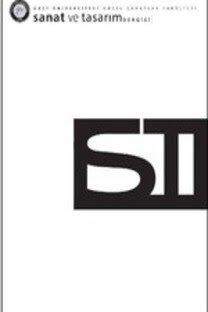Bronz Heykelde Kullanılan Yapay Patinanın Seramik Bünye Üzerinde Yeni Uygulama ve Sonuçları
Seramik, Alternatif Seramik Yüzeyleri, Heykel, Yapay Patina Bronz Oksidasyonu, İmitasyon
The New Aplication and The Result of Artificial Patina Used in Bronze Sculpture on Ceramic Surface
Ceramic Alternative Ceramic Surface, Sculpture, Artificial Patina, Bronze Oxidation, Imitation,
___
- Félibien, A. (1699) “Des Principes de l’Architecture, de la Sculpture, de la Peinture, et des autres Arts qui en dependent”, Paris, 1699, Farnborough, Hants., England, p.239
- Sarnıç, K.Ö. (2016) “Seramik Malzemenin Taklit Aracı Olarak Kullanım Olanakları”, The Journal of International Social Research, 9(45), p:416 http://www.sosyalarastirmalar.com/cilt9/sayi45_pdf/3sanattarihi_arkeoloji_cografya/sarnic_kamura- nozlem.pdf (Erişim: 01 10 2018)
- Maish, J. (2015), “Bronze Patinas, Noble and Vile” (2 september 2015)http://blogs.getty.edu/iris/bronze-patinas-noble-and- vile/ (Erişim: 02.08.2018)
- Plowman J. ( 2005) , The Sculptor’s Bible, (pp.114), Pasfield, Liz (Ed.), London: A &C Black Publishers.
- Weil P.D. (2004), ‘Patina From the Historical-Artistic Point of View’ http://www.northernlightstudio.com/new/patina.php (Erişim: 19.06.2018)https://www.etymonline.com/word/imitation#etymonline_v_1528 (Erişim: 12.10.2018)
- Yasser T. (1987) , In Muqarnas: An Annual on Islamic Art and Architecture, 4 Vols (Leiden: E.J. Brill), Oleg Grabar (Eds), Bronze Shapes in Iranian Ceramics of the Twelfth and Thirteenth Centuries https://archnet.org/system/publications/con- tents/4295/original/DPC0571.pdf?1384783504 (Erişim: 05 09 2018)
- Yılmaz S. (2016), Firdevs Müjde Gökbel (ed.), Seramik: Pişirim Teknikleri ve Fırınları, (pp.106-117); Emet Egemen Aslan– Kaan Canduran (Eds), Bakır Matı Redüksiyonu Pişirim Tekniği, Ankara: Opus Basım Yayın.
- ISSN: 1308-2264
- Yayın Aralığı: 2
- Başlangıç: 2015
- Yayıncı: Ankara Hacı Bayram Veli Üniversitesi
Peter Kogler'ın Dijital Mekânları
Sergey Rahmaninov’un Çeşitli Piyano Yapıtlarında Dies Irae Motifinin İncelenmesi
Land Art'da Yeni Yönelimler: Eco Art
Hat Sanatında Müselsel Yazılar
Bronz Heykelde Kullanılan Yapay Patinanın Seramik Bünye Üzerinde Yeni Uygulama ve Sonuçları
Mimarlık ve Metinlerarasılık: Kasımpaşa Tuz Ambarı'nda Metinlerarası İzler
Serap FAİZ BÜYÜKÇAM, Tülay ZORLU
Şarkı Sözü Yazarlığına Mizahi Yaklaşım: Soner Günday Üzerine Bir İnceleme
Müzik Eğitiminin Çeşitli Boyutlarda Çocuk Gelişimine Olan Etkileri
